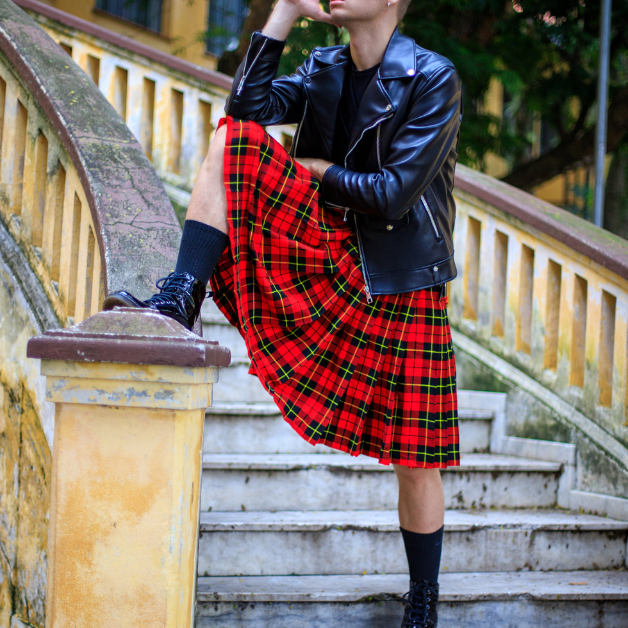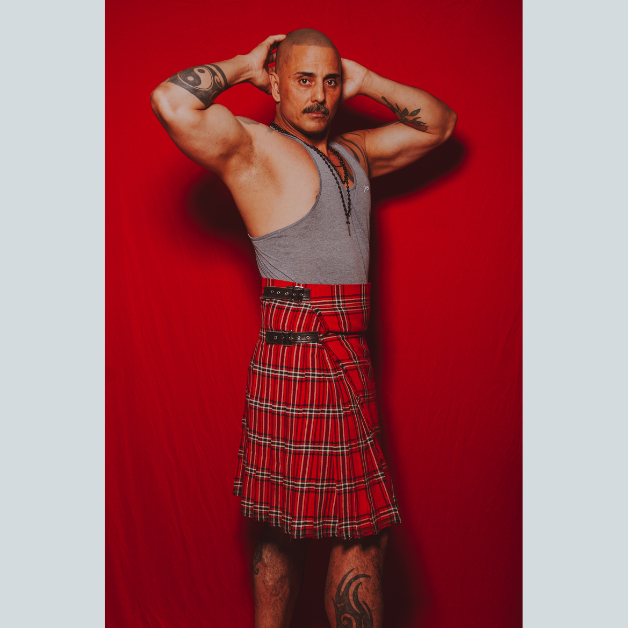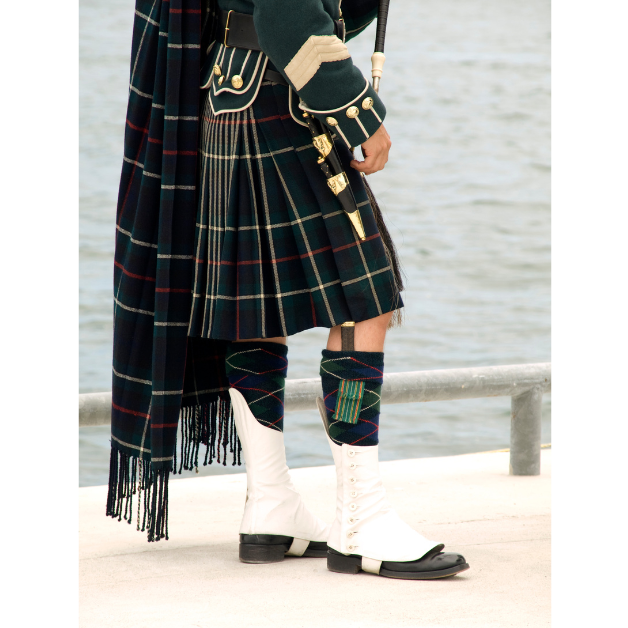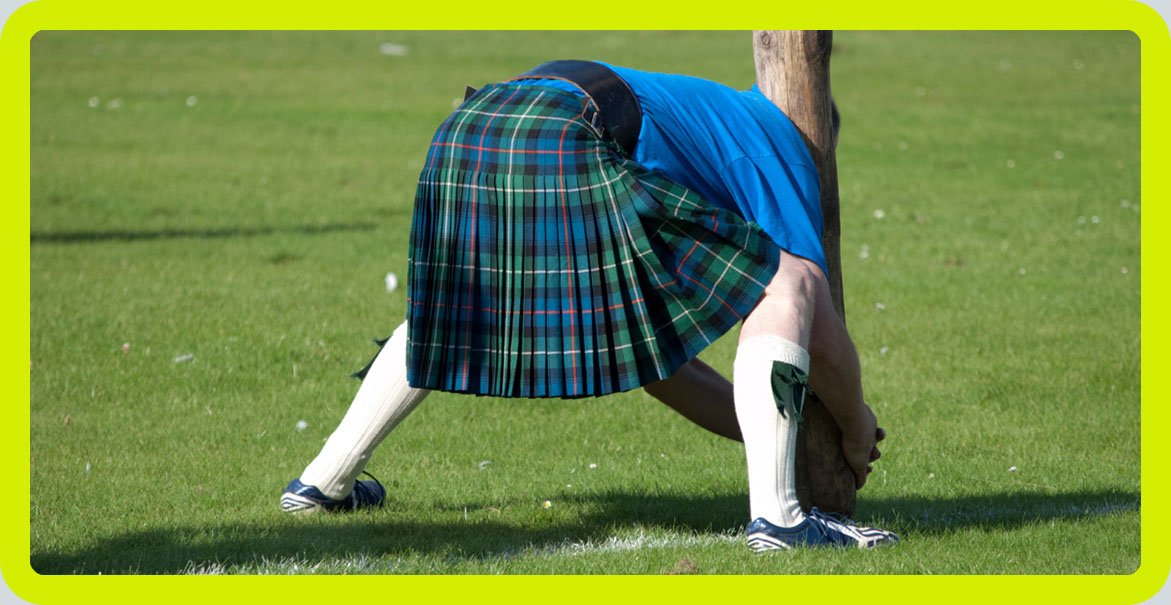So you’ve decided to don a Kilt, but now comes the age-old question: what do you wear underneath? In this article, we will discuss the options available to you, whether you prefer to stick to tradition or embrace modernity.
Wearing a Kilt is not as simple as it may seem, and understanding the appropriate undergarments can make all the difference in your comfort and style. So let’s explore the choices together and find out what goes best under your Kilt!
Understanding The Traditions of Wearing a Kilt
The Kilt is a traditional Scottish garment that holds significant cultural and historical importance. It has been worn by Scottish men for centuries and is now embraced by people around the world as a symbol of Scottish heritage and fashion.
To fully appreciate the Kilt, it is essential to understand its origin, the rules and etiquette associated with wearing one, the traditional viewpoint on undergarments, and the impact of cultural and regional differences.
The Origin of Kilts
The history of Kilts can be traced back to the Scottish Highlands, where tartan fabric was traditionally used by clans as a symbol of their identity. The Kilt, as we know it today, evolved from the belted plaid, a full-length garment draped over the shoulder and fastened around the waist.
In the 18th century, Kilts began to take the form of the tailored pleated skirt that we recognize today. Kilts have since become a proud symbol of Scottish heritage and a popular dress choice for formal occasions, weddings, and cultural events.
Rules and Etiquette of Kilt Wearing
Wearing a Kilt comes with a set of rules and etiquette that should be adhered to out of respect for tradition and Scottish culture. One important rule is to always wear the Kilt high on the waist, typically around the navel, and to ensure that the hemline falls just above or around the knee.
The pleats should be positioned at the back, and the front apron should be flat and straight. It is also customary to wear a sporran, a small pouch worn on a chain or strap that hangs in front of the Kilt, and to pair the Kilt with appropriate accessories such as a Kilt pin and a jacket.
Traditional Viewpoint on Undergarments
The issue of undergarments, or lack thereof, has long been a topic of debate and curiosity when it comes to wearing Kilts. Traditionalists argue that true Kilt-wearing entails going commando, without any form of underwear. This practice is rooted in historical accounts of Highland warriors who wore Kilts and believed that undergarments were unnecessary.
The absence of underwear is seen as a way to honor the past and embrace the simplicity and authenticity of Kilt-wearing.
Impact of Cultural and Regional Differences
While the no-underwear rule may be seen as the traditional viewpoint on Kilt-wearing, it is important to recognize that cultural and regional differences play a significant role in shaping individual approaches to this issue. In some areas of Scotland, going commando may be more prevalent, while in other regions or among certain clans, the practice of wearing undergarments with Kilts is more accepted.
Additionally, outside of Scotland, cultural norms and personal preferences further contribute to the spectrum of attitudes towards wearing undergarments with Kilts.
The Underwear Question: To Wear or Not to Wear?
The age-old controversy surrounding the wearing of undergarments with Kilts has sparked much discussion and questioning. While traditionalists argue for au naturel Kilt-wearing, others believe that modern times call for a different approach that prioritizes comfort and hygiene. Let’s explore the perspectives and opinions surrounding this underwear question.
Historic Perspective
The traditional no-underwear rule stems from a time when Kilts were predominantly worn by Highland warriors. In battle, the focus was on mobility and agility, and wearing undergarments was considered impractical. Furthermore, some sources suggest that the absence of undergarments had hygienic benefits, as the free-flowing air and natural fabrics allowed for better ventilation and reduced the risk of infections.
Current Opinions
In recent times, the debate surrounding undergarments and Kilts has become more nuanced. Many people, influenced by changing social norms and personal preferences, opt to wear undergarments for comfort and practical reasons. The wearing of undergarments provides a layer of protection, absorbs moisture, and reduces friction between the skin and the Kilt fabric. Others, however, argue that wearing underwear detracts from the authenticity and traditional essence of Kilt-wearing.
Attending Formal Events
When it comes to formal events such as weddings and black-tie occasions, the question of undergarment-use becomes particularly significant. Traditional etiquette dictates that Kilts should be worn without underwear at such events. This adherence to tradition is seen as a sign of respect for the customs and symbolism associated with Kilt-wearing.
However, it is important to consider the comfort and personal preferences of the individual as well, especially when significant time is spent wearing the Kilt.
Everyday Use of Kilts
Outside of formal events, everyday Kilt-wearing offers more room for personal choice. Many Kilt enthusiasts and wearers opt to wear underwear with their Kilts for practicality and comfort. They find that wearing undergarments provides a sense of security, prevents potential wardrobe malfunctions, and addresses concerns about modesty. Ultimately, the decision to wear undergarments or go commando depends on individual comfort and preference.
The Traditional Approach to Kilt Wearing
The traditional no-underwear rule is deeply ingrained in the history and culture of Kilt-wearing. Let’s examine the principles and circumstances that govern this time-honored approach.
No Underwear Rule
The traditional approach to Kilt-wearing involves ‘going commando’, without any form of undergarment. This practice is rooted in the idea that wearing undergarments is unnecessary and may even detract from the authenticity of Kilt-wearing. Traditionalists argue that true Kilt-wearing embraces the simplicity and minimalism of the garment.
Exceptions to the Rule
While the no-underwear rule is widely upheld by traditionalists, there are certain circumstances in which exceptions are made. For hygiene purposes, some individuals may choose to wear a thin, moisture-wicking layer of undergarment called a Kilt liner, which helps prevent excess sweat from coming into direct contact with the Kilt fabric. This compromise allows for a degree of comfort and convenience while still adhering to the principles of traditional Kilt-wearing.
Perceived Benefits
Advocates of the no-underwear rule believe that it fosters a stronger connection to Scottish heritage and tradition. They argue that wearing undergarments disrupts the natural flow of the Kilt and may result in discomfort or irritation. Additionally, by embracing the no-underwear rule, some wearers experience a sense of liberation and authenticity that aligns with their personal values.
Circumstances Influencing this Approach
The decision to go commando largely depends on the individual’s connection to tradition, personal beliefs, and the specific occasion. For some wearers, adhering to tradition can be a matter of personal pride, while others may simply adhere to the no-underwear rule during cultural events or gatherings where homage to tradition is highly valued. Ultimately, the choice to embrace the traditional approach to Kilt-wearing rests with the individual and their connection to Scottish heritage.
Modern Perspective on Kilt Wearing

As times have changed, so too have attitudes towards Kilt-wearing. Let’s explore the contemporary take on wearing Kilts, including preferences for undergarments, popular types of underwear under Kilts, and the factors driving modern attitudes.
Contemporary Take on Kilt Wearing
In modern times, wearing undergarments with Kilts has become more common and accepted. Recognizing the comfort and hygiene advantages, many individuals choose to wear underwear as a practical measure. This shift in perspective does not diminish the appreciation for tradition and Scottish culture but acknowledges the evolving needs and preferences of Kilt-wearers.
Preference for Undergarments
The preference for wearing undergarments with Kilts is often driven by factors such as comfort, modesty, and personal hygiene. Underwear provides an additional layer of protection, absorbs sweat, and reduces friction between the skin and the Kilt fabric. Moreover, some wearers simply feel more at ease knowing that they have an extra layer of coverage.
Popular Types of Underwear under Kilts
When it comes to choosing the right underwear for Kilt-wearing, there are various options to consider. Many individuals opt for seamless, moisture-wicking boxer briefs or trunks that provide support and prevent chafing. Others prefer athletic-style briefs or specialized Kilt undergarments that are specifically designed to be worn with Kilts. The choice depends on the individual’s comfort, activity level, and personal preferences.
Factors Driving Modern Attitudes
Modern attitudes towards Kilt-wearing and undergarment use are influenced by a range of factors. The desire for comfort, increased focus on hygiene, and changing social norms all play a role in shaping contemporary perspectives. Additionally, the globalization of Kilt-wearing has led to the assimilation of various cultural practices and individual choices, further contributing to the diversity of approaches.
Public Opinion on Undergarment Use
The question of whether or not to wear undergarments with a Kilt has sparked significant public interest and discussion. Let’s delve into the opinions expressed by different groups, including survey results, gender differences in perception, views from different age groups, and the influence of media and pop culture.
Survey Results
Surveys conducted on the topic of undergarment use with Kilts have yielded diverse insights. While some surveys show a majority leaning towards wearing undergarments, others indicate almost an equal split between those who choose to wear underwear and those who go commando. These results demonstrate the ongoing debate and the personal nature of the decision.
Gender Differences in Perception
Public opinion on the underwear question also varies across genders. Some women and men of both traditional and modern mindsets may believe that wearing undergarments is important for personal comfort and modesty. On the other hand, others argue that adhering to the traditional no-underwear rule is vital for men to fully embrace the spirit and authenticity of Kilt-wearing.
Opinions from Different Age Groups
The question of undergarment use with Kilts also transcends generational lines. Younger individuals, influenced by changing social attitudes, are generally more open to wearing undergarments with Kilts.
Older generations, who may place a stronger emphasis on tradition, are more likely to adhere to the no-underwear rule. However, these generalizations do not apply to everyone, as personal preferences ultimately drive the decision.
Influence of Media and Pop Culture
Media and pop culture have undoubtedly played a role in shaping public opinion on undergarment use with Kilts. Movies, television shows, and advertisements often depict Kilt-wearing characters in both traditional and modern contexts, highlighting different approaches to undergarment use. This exposure to diverse perspectives has further fueled the ongoing discourse and brought the underwear question into the public consciousness.
Events and Kilt Etiquette
Understanding Kilt etiquette is crucial when attending various events. The customs and expectations surrounding Kilt-wearing differ depending on the occasion. Let’s explore the approach to undergarments at weddings and formal gatherings, sporting events and Highland games, as well as cultural and community festivals.
Weddings and Formal Gatherings
In the context of weddings and formal gatherings, adhering to tradition is typically encouraged. It is customary for men wearing Kilts to go commando, as it is seen as a sign of respect for Scottish heritage and customs. However, it is essential to consider individual comfort and preferences, especially when it comes to long hours of wear during these events.
Sporting Events and Highland Games

Attending sporting events and Highland games offer opportunities for Kilt-wearers to showcase their Scottish heritage and cultural pride. In these settings, personal comfort and practicality often take precedence over strict adherence to traditional practices. Many Kilt enthusiasts opt to wear undergarments to maintain comfort and flexibility during active events.
Cultural and Community Festivals
Cultural and community festivals celebrate Scottish traditions and provide platforms for Kilt-wearers to gather and showcase their attire. The approach to undergarments varies, with some participants choosing to go commando as a gesture of homage to tradition, while others prioritize personal comfort by wearing undergarments. These festivals embrace diversity and personal choice, allowing individuals to express their Kilt-wearing preferences freely.
Approach to Undergarments at Various Events
When deciding whether to wear undergarments at different events, it is crucial to consider the nature of the occasion, personal comfort, and respect for tradition. While some events necessitate adherence to traditional practices, others allow for greater flexibility based on individual preferences. Ultimately, the choice of undergarment use should be driven by personal comfort and alignment with the spirit of the event.
Comfort Factor
Comfort is a crucial consideration when wearing a Kilt, and the decision to wear undergarments or not can significantly impact the overall comfort level. Let’s explore the factors related to body comfort without underwear, the feel of different fabrics, climate considerations, and engaging in physical activities while wearing Kilts.
Body Comfort Without Underwear
For those who adhere to the tradition of going commando, body comfort depends on factors such as the fit of the Kilt, the quality of the fabric, and personal preference. Some individuals find that the freedom of movement and direct contact with the Kilt fabric contribute to a heightened sense of comfort and closeness to tradition. However, it is important to ensure that the Kilt is properly tailored and that the fabric is breathable and non-irritating against the skin.
Feel of Different Fabrics
The choice of fabric plays a significant role in determining the comfort of wearing a Kilt. Traditional tartan fabrics, such as wool and tweed, offer breathability and durability but may be heavier and coarser against the skin. Modern Kilt fabrics, such as acrylic blends or lightweight cotton, provide a softer feel and enhanced comfort. Ultimately, it is essential to select a fabric that aligns with personal comfort preferences.
Climate Considerations
The climate in which the Kilt is worn also impacts comfort levels. In colder climates, the warmth provided by traditional wool Kilts can be appreciated, while in warmer climates, lighter fabrics or moisture-wicking materials may be more comfortable. Layering options and adjusting the density of the fabric can also help regulate body temperature and ensure optimal comfort.
Physical Activities in Kilts
Engaging in physical activities while wearing a Kilt presents unique challenges and considerations. The absence of undergarments may provide a greater range of movement and ventilation, but it may also expose individuals to discomfort and potential chafing or irritation. For more active pursuits, some Kilt-wearers opt for specialized athletic undergarments that provide additional support and moisture-wicking properties.
Choosing the Right Undergarment for Your Kilt
When opting to wear undergarments with a Kilt, choosing the right type is essential. Let’s delve into the factors to consider when selecting the appropriate material, size, and color of undergarments, as well as the availability of specialty undergarments designed specifically for Kilts.
Material Selection
When it comes to choosing the material for undergarments worn with Kilts, comfort and breathability are paramount. Moisture-wicking fabrics, such as lightweight blends or high-performance synthetics, are often preferred for their ability to keep the skin dry and prevent irritation. Natural fibers like cotton or bamboo can also provide softness and breathability.
Appropriate Sizes
To ensure optimal comfort, it is important to select undergarments in the correct size. Ill-fitting undergarments can lead to discomfort, chafing, and a lack of support. Taking accurate measurements and referring to size charts can help identify the right fit, ensuring that the undergarments do not bunch up, sag, or create visible lines under the Kilt.
Color Matching with Your Kilt

While undergarments are typically hidden from view, color coordination can enhance the overall aesthetic appeal. Many Kilt-wearers opt for neutral-colored undergarments that seamlessly blend with the Kilt fabric. This minimizes the risk of visible lines or contrast, allowing the focus to remain on the Kilt itself.
Specialty Undergarments for Kilts
In response to the evolving preferences of Kilt-wearers, specialty undergarments have been designed specifically for Kilts. These undergarments often feature unique features such as built-in modesty panels, moisture-wicking capabilities, and supportive design elements. These specialized options cater to individuals seeking a balance between comfort, functionality, and adherence to tradition.
Potential Negatives of Wearing No Undergarment
While the tradition of not wearing undergarments with a Kilt is deeply rooted in history and cultural significance, there are potential drawbacks and negatives to consider. Let’s explore the risks of exposure, health considerations, comfort concerns, and social implications associated with going commando.
Risk of Exposure
One of the most commonly cited concerns associated with going commando is the risk of exposure. Wind, movement, and improper Kilt handling can unintentionally lift the Kilt, exposing the wearer to potential embarrassment or discomfort. This risk can be mitigated by ensuring proper Kilt fit, using accessories like sporran chains to secure the Kilt, and practicing proper Kilt etiquette.
Health Considerations
While some historical arguments highlight hygienic benefits associated with not wearing undergarments, there are health considerations to keep in mind. The absence of undergarments can lead to increased friction between the Kilt fabric and the skin, potentially causing irritation or chafing. Furthermore, individuals with certain medical conditions or sensitivities may find that wearing undergarments offers an added layer of protection and comfort.
Comfort Concerns
Comfort is a subjective experience, and while some individuals find going commando comfortable, others may have different preferences. Factors such as body shape, fabric choice, climate, and personal comfort thresholds can influence the level of comfort experienced when not wearing undergarments. It is essential to prioritize personal comfort when deciding whether or not to embrace the traditional no-underwear approach.
Social Implications
Social implications represent another potential negative associated with not wearing undergarments. In certain settings, cultural events, or communities, adhering to tradition and going commando may be highly valued and respected. However, in other contexts, not wearing undergarments may be perceived as inappropriate, unhygienic, or disrespectful. Considering social norms and expectations can help ensure that the decision aligns with the values and customs of the given environment.
The Future of Kilt Wearing: A Balance of Tradition and Modernity
The ongoing debate surrounding the wearing of undergarments with Kilts signifies the dynamic nature of cultural practices and personal preferences. The future of Kilt-wearing is likely to involve a balance between tradition and modernity, incorporating respect for heritage while embracing individual comfort and practical considerations.
Changing Cultural Perceptions
Cultural perceptions around Kilt-wearing have evolved over time, and this will likely continue in the future. As societal norms continue to shift, individuals may feel increasingly empowered to make decisions based on personal comfort and values while still paying homage to tradition. This shift is indicative of the broader evolution of cultural practices and the acknowledgment that there is not a one-size-fits-all approach to Kilt-wearing.
Influence of Kilt Manufacturers and Retailers
Kilt manufacturers and retailers play a significant role in shaping the future of Kilt-wearing. By offering a wide range of Kilt styles, fabrics, and accessories, they allow individuals to customize their Kilt-wearing experience according to their preferences. They also have the power to introduce and promote specialized undergarments designed specifically for Kilt-wearers, bridging the gap between tradition and modernity.
Possible Trends in Undergarment Use
The future of undergarment use with Kilts may witness a growing acceptance and incorporation of both traditional and modern approaches. Flexibility and individual choice may become more prevalent, allowing Kilt-wearers to decide on a case-by-case basis. It is likely that innovative undergarments catering to Kilt-wearers will continue to emerge, providing options that balance comfort, functionality, and adherence to tradition.
Balancing Respect for Tradition and Personal Comfort
As we move forward, the challenge lies in striking a balance between respecting tradition and embracing personal comfort. The future of Kilt-wearing should allow individuals the freedom to make choices that align with their values, cultural connections, and comfort boundaries. By fostering a culture of inclusivity and understanding, it is possible to honor the rich heritage of Kilt-wearing while embracing the diversity of modern attitudes.
In conclusion, understanding the traditions of wearing a Kilt requires an exploration of its origin, rules, and etiquette, as well as the traditional and modern perspectives on undergarment use. The ongoing debate surrounding this topic highlights the dynamic nature of cultural practices and personal preferences. Whether one chooses to go commando or wear undergarments, it is important to balance respect for tradition with personal comfort and practical considerations. As Kilt-wearing continues to evolve, it is crucial to foster a culture of inclusivity and understanding that celebrates the rich heritage of the Kilt while embracing the diverse perspectives of Kilt-wearers around the world.

